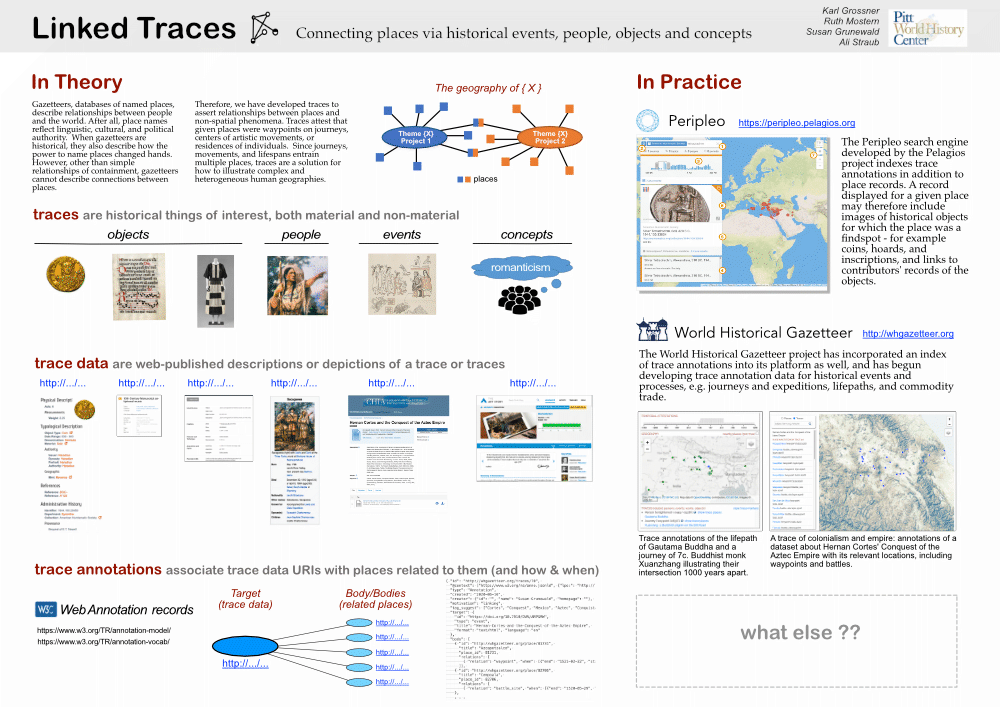Linked Pasts is an annual symposium. Linked.Art and Linked Places are data models with associated format specifications. Can we manage one more Linked something? Rainer Simon and I have begun an initiative to develop a Linked Traces annotation model and file format as a standard for contributions to linked open data aggregation projects such as World-Historical Gazetteer and Pelagios. The effort could easily extend to software and systems for displaying, searching, and analyzing trace data. The idea has drawn considerable interest, so here are some thoughts to start a discussion…and action.
What is a trace?
For our purposes a trace is any historical entity having a spatial-temporal setting (i.e. footprint) of interest—very general! The types of traces we’re immediately focused on include: people and groups of people, events of any complexity, and artifacts of all kinds (e.g. objects, texts, art works).
What is trace data?
Trace data are annotations of web-published records about (and images of) trace entities. We posit here that the body of a trace annotation must include a place reference (URI and name/title), should include a relation (e.g. waypoint, findspot, birthplace), and could include a temporal scope for that relation. Properties like creator and date are musts also. Trace data should take the form spelled out in the W3C Web Annotation Model and Vocabulary, in the JSON-LD syntax of RDF. Draft examples of some trace annotations have been posted in a GitHub repository for discussion. There are a few outstanding issues that need community consensus to resolve, outlined below.
Why trace data?
The Peripleo pilot application launched a few years ago by the Pelagios project is an example of traces in action. Underlying Peripleo is an index of a) place records aggregated from multiple gazetteers, and b) what we are now calling trace data: annotations of records about ancient coins, coin hoards, and inscriptions with relevant locations such as find spots.
There are many other kinds of things associated with places—at times or during periods—we might like to see, compare, and analyze as elements of “deep” linked data place records in future Peripleo-like software (e.g. World-Historical Gazetteer, now in development). For a given place, discover not only what museum artifacts or inscriptions were found there, but what historical persons are associated with the place, and in what way; what journeys of exploration or pilgrimage it was a waypoint on; and what texts and art works it is a subject of.
We have already heard from people with Person and Event data, and Rainer notes that this should support annotations of IIIF-formatted manuscripts and other images.
One sample
Here is one sample draft annotation record for a Journey event. As mentioned, more examples are on GitHub.
{ "@context":[
"http://www.w3.org/ns/anno.jsonld",
{ "lpo": "http://linkedpasts.org/ontology/lpo.jsonld"}
],
"id": "http://my.org/annotations/92837",
"type": "Annotation",
"creator": {
"id":"http://example.org/people/2345",
"name":"Ima Tracemaker",
"homepage":"http://tracemaker.org"},
"created": "2019-03-18",
"motivation": "linking",
"body": [
{"id": "http://whgazetteer.org/places/86880",
"dc:title": "Tashkent",
"lpo:relation": "lpo:waypoint",
"lpo:when": {"timespans":[
{"start":{"in":"630"},"end":{"in":"630"}}]}
},
{"id": "http://whgazetteer.org/places/84774",
"dc:title": "Mathura",
"lpo:relation": "lpo:waypoint",
"lpo:when": {"timespans":[
{"start":{"in":"634"},"end":{"in":"634"}}]}
},
// ... etc.
],
"target": {
"id": "http://my.org/events/90001",
"type": "lpo:Journey",
"dc:title" "Pilgrimage of Xuanzang"
}
}
Open questions
The next step is for a working group to collectively answer existing open questions, and to surface (and answer) questions we haven’t thought of. We welcome collaborators and observers. A few questions that came to mind while developing the prospective samples:
- What are the types of traces (annotation targets)?
- Should there be a vocabulary of type-specific relations? E.g. waypoint for Journey traces, or birthplace for Persons.
- How can bodies (place/time assertions) be combined as sequences in sets for a given target? E.g. Journey waypoints.
- How can relations be combined in sets? E.g. a Place was both a birthplace and deathplace for a Person.
- Where can “when” be expressed in an annotation? E.g. in #4, can a date be associated with each relation to the Place?
- How should “extension” terms we introduce (and allowed by the W3C spec) be defined? In a “Linked Pasts Ontology”? What will be its contents?
Undoubtedly more will surface.
Next steps
I’ve created a Google Group email list for tracking conversation amongst collaborators and observers, and posted parts of this document as an editable Google Doc. After some initial feedback perhaps we should have a Google Hangout. (My plan to begin extracting Google from my life is not going well!) Suggestions for other tools and platforms are welcome.



